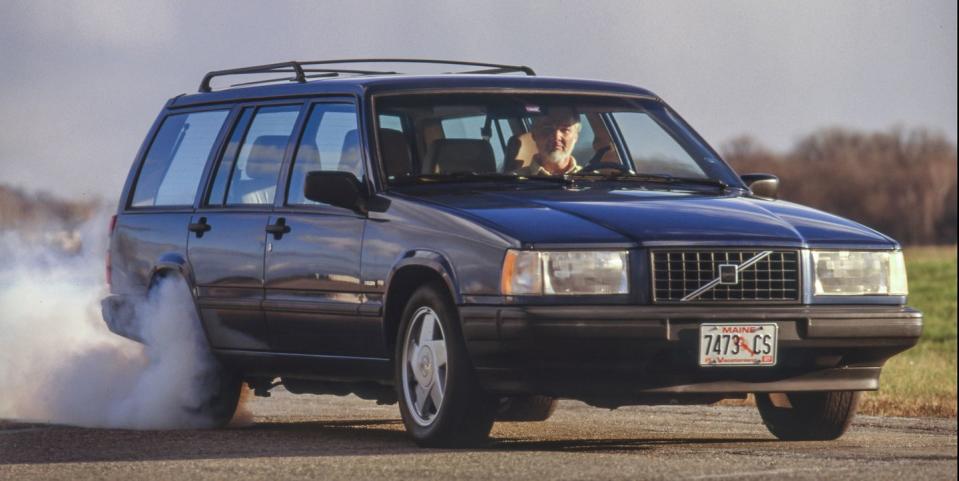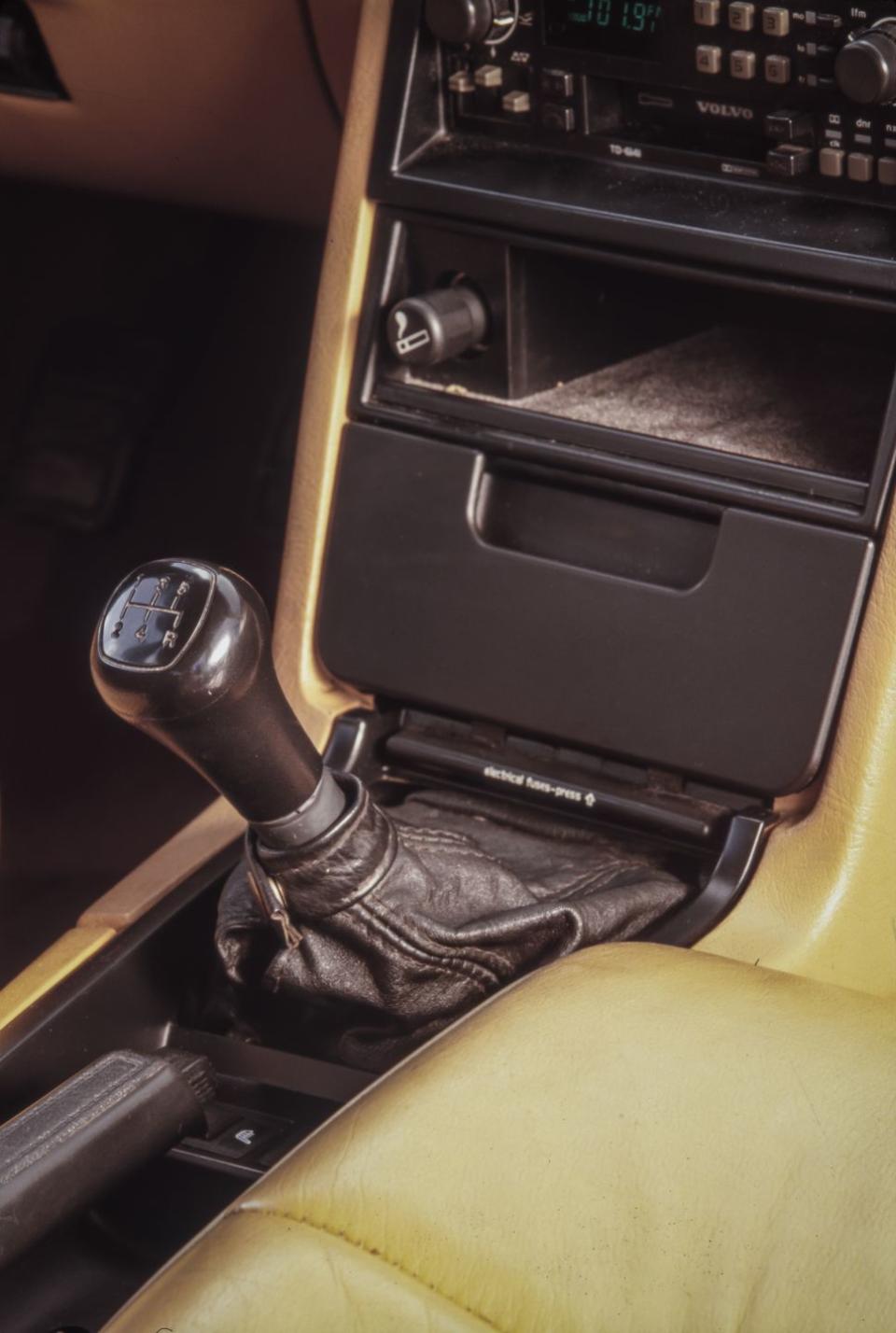Tested: Old Volvo Wagons Are a V-8 Swap from Serious Speed

From the June 1997 issue of Car and Driver.
"I'm a little worried if you mention Paul Newman," says Ross Converse, a former aircraft mechanic whose primary business since 1988 has been selling simple kits to slot Mustang V-8s into rear-drive Volvos.
Converse, a soft-spoken 46-year-old Mainer, is more concerned that Indy-car team owner and actor Newman will be angry with him for divulging a secret: Known fast-car lover and salad-dressing-and-salsa salesman Newman tools around his home base in Connecticut in a V-8-powered Volvo 960 wagon built by Converse.
See, one of the advantages of having a V-8-powered Volvo, especially in the Northeast, is that Swedish cars blend into the traffic like Toyotas in Tokyo. Cops and autograph hounds normally tend not to notice ubiquitous Volvo station wagons.
The other reason is this: A Volvo wagon weighs only 100 pounds more with an iron-block Mustang V-8, so performance improves. In fact, one of the two Converse-built Volvo wagons we tested got to 60 mph in 5.9 seconds. It was a special version, with a Powerdyne Automotive Products centrifugal supercharger driven by a shielded, toothed belt. It was as quick as the convertible Mustang Cobra we tested last July. In fact, that Volvo got down the quarter-mile in 14.3 second at a trap speed of 100 mph, faster than July's Cobra. Top speed for the station wagon is 145 mph. That's 1 mph faster than the sizzling 850 Turbo wagon we tested last March. Our second test subject from Converse had a stock Mustang engine and a four-speed automatic; it made it to 60 mph in a still-zoomy 7.4 seconds. A new 740 Turbo wagon reached 60 mph in 8.0 seconds and took the quarter in 15.9 at 85 mph back in May 1985. Throttle response in both cars is quick, and you can spin the stock-size tires at most speeds on a whim.

In eight years, Converse has built 50 of the V-8-powered cars and has sold 150 kits for do-it-your-selfers. It's by nature not a lucrative business, since he charges just $750 for the parts or $1700 for doing the engine swap himself. The supercharger is a popular upgrade priced at $2500, and it takes two to three hours to install, says Converse. Our blown test car also had 89,000 miles on the odometer, making it relatively new for the average Converse conversion.
"It was a lot of fun riding with, you know, Newman, as he slid the car through some corners at 90 mph," Converse recalls, reveling in the pure adolescence of one shakedown trip with the 72-year-old Newman. But the low-key Converse gets nervous about us mentioning his famous clients. The trouble started when another Indy-car team owner, late-night TV host David Letterman, bought one of Converse's V-8-powered Volvo wagons and was so excited that he let it slip—to the whole world—that Newman had one, too. Appearing on the now-defunct Jon Stewart Show, Letterman revealed: "Six months ago, Paul Newman calls up. 'Dave, I'm thinking about getting a Volvo station wagon, with a Ford 302 V-8 the size of a small piano. Do you want one? '"

Letterman continued: "Paul told me from 20 to 100 [mph] you can chew anybody's ass. What circumstance would Paul find himself in while driving around in a Volvo station wagon where he feels he's got to chew somebody's ass?"
Letterman was chastised for his loose lips: "The guy gets a little cranky about mentioning his name," Letterman told interviewer Al Roker on CNBC later. Newman, you see, wanted a car he could drive fast but not be noticed in. But Letterman revealed that Newman had already been stopped by the cops. "It's like driving a go-kart or a jet fighter," adds the toothy TV star.
Converse designed the package to be an affordable way to preserve otherwise sound Volvos; Newman wanted a supercharger and a bunch of engine tweaks, cost no object. Cost, however, was the major motivator for Converse's conversions. Converse lives on a dirt road on the outskirts of Portland and does all his work in a modest-sized garage. Modest, that is, to a car fan like Newman. Extravagant, perhaps, to Converse, who once lived for two years in the Maine woods in the back of a delivery truck. He also lived in a BMW 1600 sedan for a few weeks in the 1970s and spent a couple years as the live-in mechanic for a wealthy gentleman in North Carolina ("It sure was a lot warmer there than in Maine"). He went to school to learn to be an aircraft mechanic, but his Yankee-inventor, hot-rodder personality became frustrated with strict FAA regulations that discourage the hot rodding of airplane engines.
Converse is always eager to recycle. In high school, he bolted an aluminum Buick V-8 into a worn Datsun 510. He built his first V-8 Volvo for his 75-year-old mother. At the time, Converse noticed there were plenty of the strong, Swedish wagons available in salvage yards in the Northeast, most suffering from engines that hadn't been maintained properly. "Diesels blow up all the time," he says. "No, they do. I wanted to replace a diesel engine with one that was absolutely cheap to maintain, and if it made more power, then all the better."
He chose the Mustang V- 8 over a small-block Chevy simply because the distributor location on the Ford motor fit more easily under the Volvo hood.
Converse makes a wiring harness that plugs into both the Volvo chassis and the Ford engine harnesses, and solders a 33-cent resistor into the tachometer circuit board of the Volvo so it will read properly with the Ford V-8. The five-speed shifter from the Ford transmission pokes up through a Volvo shift boot, but the fabricated shift lever Converse adds to the transmission uses the Mustang shift knob. "We love recycling parts, using cheap parts and covering them up," he explains.

The Volvo driveshaft is shortened and balanced, and a new yoke is added to mate it to the Ford transmission. The rear end remains stock. "Volvo uses Dana 30 guts in its housings," he says, which makes him confident about the durability of the pieces. Engine mounts are fabricated from mild steel.
Our supercharged test wagon had one stock Ford catalytic converter mated to the stock-Volvo resonator for exhausting the right bank of cylinders, and the left bank was plumbed with the second stock Mustang catalytic converter and the stock Mustang muffler. "I'm always trying to figure out how to reuse things," says Converse. So, none of the exhaust pieces went to waste. The downside is you wind up with two tailpipes that look completely different.
Newman's and Letterman's cars began life as brand-new 960 wagons, but most of Converse's customers own high-mileage Volvos. They come to Converse because they are concerned about the reliability of their well-used drivetrains, he says. Our supercharged test car was a solid and rattle-free 1990 740 Turbo that rode soundly enough to belie its seven years of age. Its V-8 and five-speed were from a 1991 Mustang. The normally aspirated tester was a 1986 740, with a 1989 Mustang powertrain.
High-mileage Volvo wagons are cheap: "Anything with 240,000 miles on it is only $2000 to buy," says Converse. "We've converted a number of cars that had over 200,000 miles on them. We go around on an anti-squeak campaign, replacing suspension and body bushings. At 200,000 miles, a Volvo body is still good, but what makes it feel old is rattles and squeaks."
And complaints from famous folks who don't appreciate the frugality of the conversion as much as they do the performance.
Converse Engineering, 14 Caldwell Street, Portland, Maine 04103; 207-828-6795.
You Might Also Like

 Yahoo Autos
Yahoo Autos 